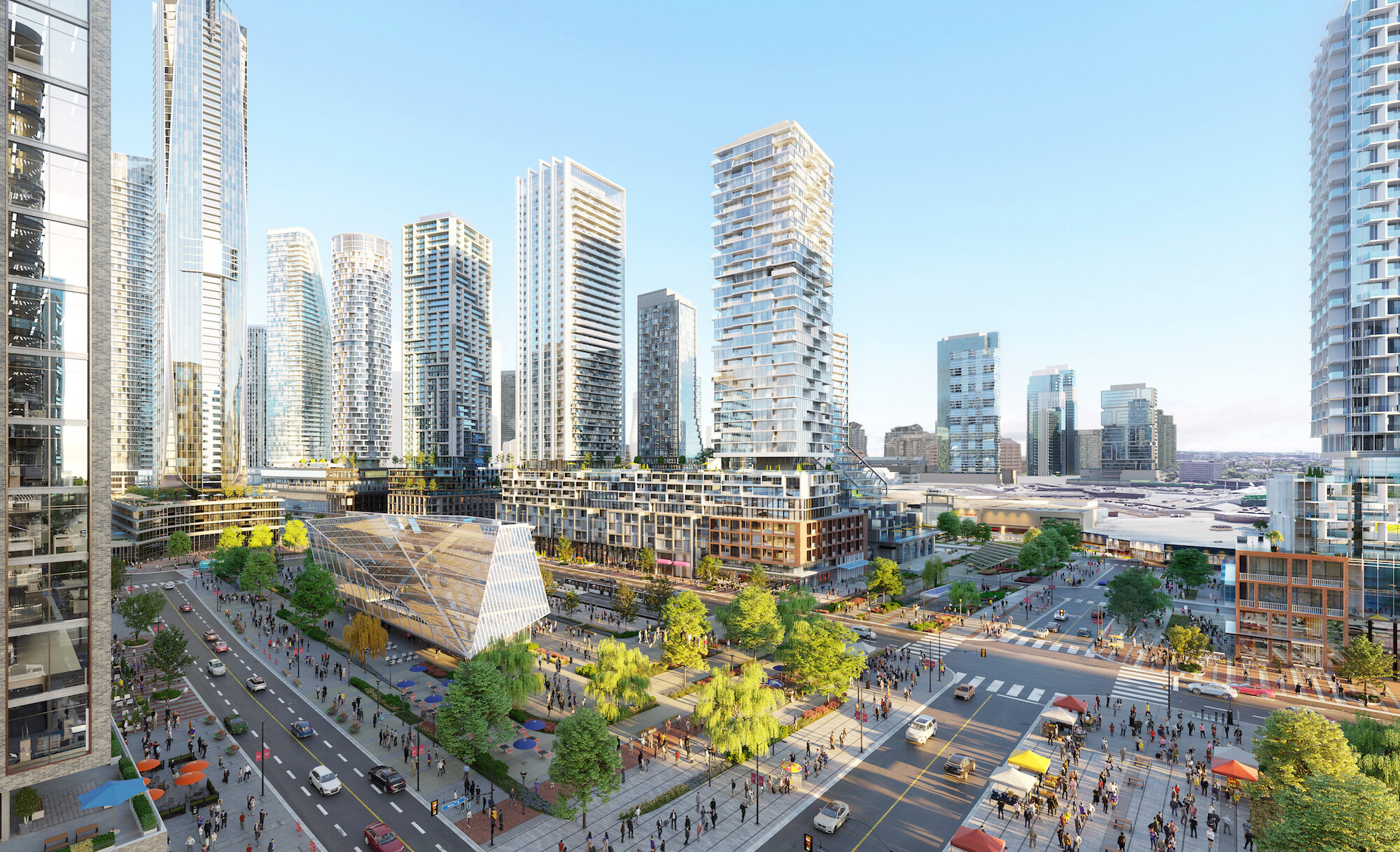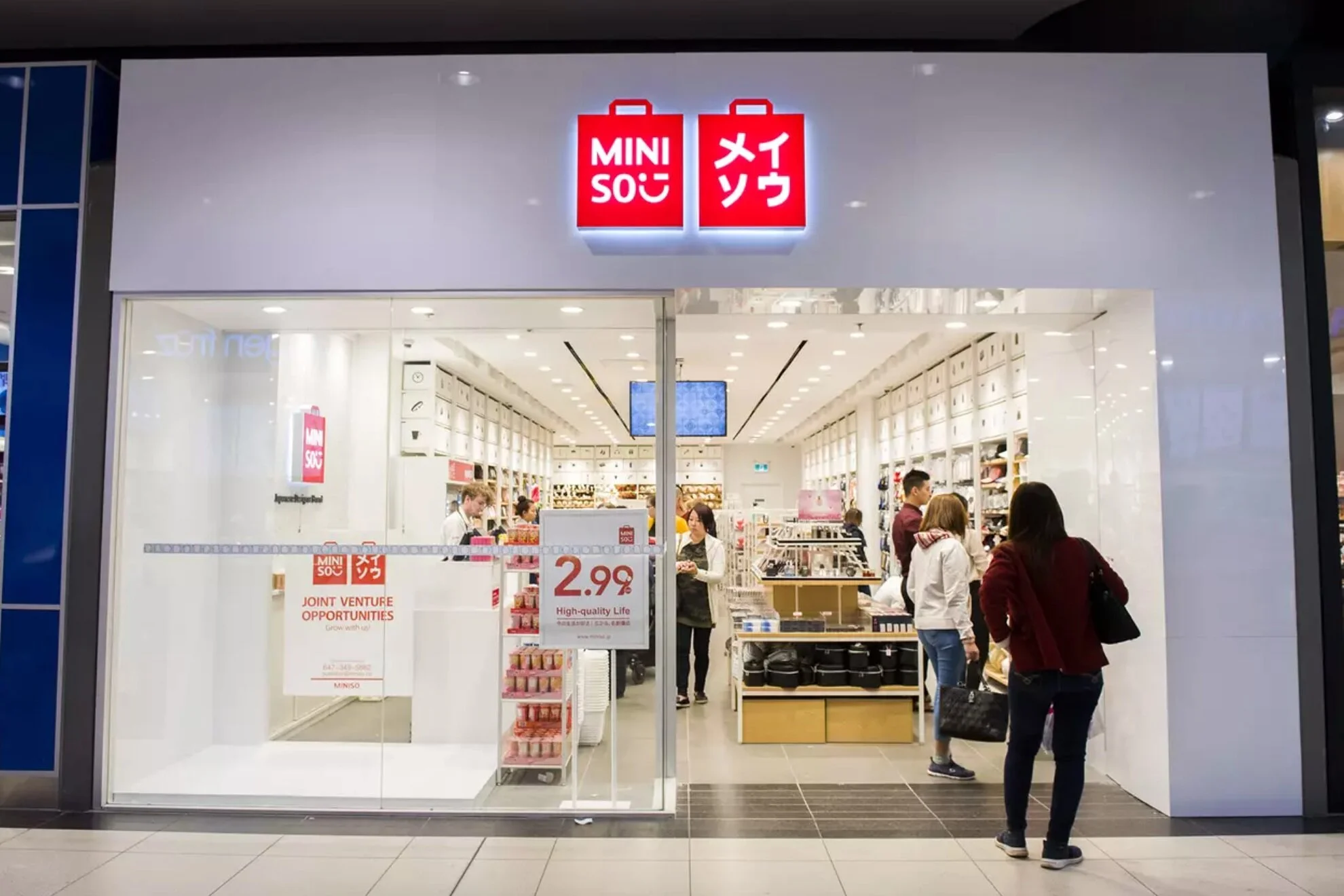Mississauga’s Square One Shopping Centre to Become the Largest Mixed-Use Development in Canadian History [Renderings]
/rendering: the strand, looking west down rathburn
By Craig Patterson
Landlord Oxford Properties has revealed details on a groundbreaking development that will transform the area around Mississauga’s Square One shopping centre into the largest mixed-use development in Canadian history. The massive ‘Square One District’ project will see thousands of residential units added to the property as well as new office buildings, park space, and a major transit hub, all of which will redefine downtown Mississauga for generations to come.
The incredible project will be made possible by densifying the vast under-utilized parking lots and buildings surrounding the existing Square One shopping centre. Oxford Properties owns the 130-acre site which includes one of Canada’s leading shopping centres as well as several low-density buildings surrounding it. The Daniels Corporation partnered with Oxford Properties and AIMCo on the first phase of the redevelopment.
Groundbreaking developments on the Square One District will begin in the fall of 2020 and and the project will be completed in phases over several decades. Hariri Pontarini Architects are responsible for the masterplan. The existing shopping centre property will remain intact though it too will see changes in years to come.
rendering: square one district site in Mississauga
The 18 million-square-foot master-planned mixed-use development is being touted as a “neighbourhood of the future”. Swaths of parking lots will be densified with 37 residential towers housing more than 18,000 residential units that will become home to an estimated 35,000 residents when completed. More than half of the units will be rental apartments.
Residential towers will be built in phases in the years to come and the first two residential towers will break ground this fall. A 36-storey rental tower will include 420 rental apartments and a 48-storey tower housing 570 condominium units. Pre-sales for the condominium tower will begin this spring. An additional 5,000 residential units on the site will be launched over the next five to seven years.
Residential units in the Condominiums at Square One District will span be between 444 square feet for studio units to 844 square feet for two bedroom plus den units — the Greater Toronto Area is known for its relatively small condominium units when compared to markets such as Chicago. In the rental tower, units will start at 408 square feet for a studio and will go up to 1,121 square feet for a three bedroom unit.
Drone flies over Square One in Mississauga, Ontario, showcasing vast parking lots and under-utilized land that will be redeveloped via intensification in the coming years.
rendering: street view of the strand, the walkable and pedestrian-friendly heart of square one district
Several new office towers will be part of the project as well, which will be the first commercial development in downtown Mississauga in a generation. Oxford Properties will begin marketing the first office tower to prospective tenants in the second quarter of 2020. New office buildings will provide employment on the site, further strengthening Mississauga’s economy for years to come. Mississauga is already a significant employment hub and is home to numerous corporate headquarters and other employment nodes.
At the heart of the new Square One District will be ‘The Strand’, which is described as a pedestrian-friendly connected civic space that will be anchored by a transit hub as well as a community park. The district will be connected to both the Hurontario LRT line as well as Rapid Bus Transit that serves the region. The development is said to align with the City of Mississauga’s vision of creating a vibrant downtown core.
In an effort to create a complete community, the Square One District will also include community buildings as well as various parks and green spaces in addition to The Strand.
Thousands of jobs will be created as part of the Square One District project. The first phase of construction will create 3,500 jobs and in the first five years, about 6,500 direct jobs will be created. Over the life span of the project, 35,000 direct jobs will be created.
rendering: ariel view of the strand looking west with transit mobility hub connected to hurontario lrt in foreground
When the Square One mega project is completed, downtown Mississauga will be one of the most populous in Canada. Over the next two decades, downtown Mississauga is expected to double in population and could approach 100,000 residents. Downtown Toronto’s population is said to be approaching 300,000 people within its boundaries. The downtown Vancouver peninsula houses more than 110,000 residents and downtown Montreal is home to about 125,000 residents currently.
Square One has seen significant updates over the years which has made it one of Canada’s leading shopping centres. Square One ranked as Canada’s seventh most-productive shopping centre in terms of annual sales per square foot in 2019, surpassing $1,100 for the first time. The centre spans nearly two million square feet and sees about 23 million visitors annually, making it one of the largest and busiest shopping centres in Canada. That’s according to Retail Council of Canada’s latest Canadian Shopping Centre study which was recently released to the public.
rendering: public space within the strand
The 2.2 million-square-foot Square One shopping centre itself could be considered to be the most diverse centre in Canada in terms of its retail offerings. Anchors range from value-priced to luxury stores. A 225,000-square-foot Walmart store is located at one end of the centre and in the summer of 2016, Holt Renfrew opened a stunning 140,000-square-foot store in a newly opened luxury wing which also houses names such as Harry Rosen and Salvatore Ferragamo. The mall’s other anchors include a 109,000-square-foot La Maison Simons store which opened in 2016 as well as a 203,500-square-foot Hudson’s Bay store which is one of the leading stores in the chain. Square One houses more than 360 stores and 100 bars, restaurants, and eateries. About 9,500 people are employed at Square One, which opened in October of 1973.
Last spring, Square One also added a new food hall called the Food District, as well as food and entertainment concept The Rec Room. Various new retailers such as Uniqlo and Indigo were added to the property. Other retailers at Square One range from international concepts to local brands. Over the past five years, Square One has seen more than $500 million invested into the property. That includes elevating the customer offering while strengthening food, beverage, and entertainment options.
square one shopping centre. rendering: oxford properties
Entertainment will continue to drive traffic to Square One. A Dr. Seuss experience was added to a building on the property near the mall last year, and a new interactive and educational and entertainment centre is also now under construction and is set to open later this year, with details to follow.
Oxford Properties is intensifying several of its other shopping centre properties in the Greater Toronto Area. A proposal for Toronto’s Scarborough Town Centre could see 36 new residential towers added to the site that would eventually house as many as 30,000 people while the existing mall remains operational. Toronto’s Yorkdale Shopping Centre will also see a significant intensification in years to come that will include new residential towers as well as office buildings and a new hotel. Other Oxford malls such as Hillcrest in Richmond Hill will also see significant changes.
It’s part of a larger endeavour on the part of Canadian landlords to intensify shopping centre sites. Landlords stand to profit greatly as developers intensify low-density sites, adding much-needed housing in areas that may have housing shortages. That’s particularly the case in the Toronto and Vancouver markets, where most of the large shopping centre properties are in line for significant intensification, often with a focus on residential buildings to create complete communities.
square one the food district. photo: tara noelle
Adding housing to shopping centre properties makes sense. It supplies a resident population to shop in the on-site mall, adding vibrancy to the area. Furthermore, most shopping centre sites are accessible by transit which makes residential intensification desirable. A recent study by International Council of Shopping Centres found that 87% of Canadians would consider living on such properties, which is considerably higher than in years past.
The most recent Retail Council of Canada shopping centre study lays out dozens of shopping centres in Canada that will see intensification in years to come. The study can be downloaded here. The study lays out which centres will see redevelopments and what they might entail. Ultimately, the face of Canadian cities will change as a result as shopping centre properties are transformed to become mixed-use community gathering places.
rendering: the first phase of development featuring two residential towers
Mississauga is Canada’s sixth largest city with a population approaching 800,000. By 2041, the city is expected to be home to 920,000 people and will boast about 565,000 jobs. Interestingly, Mississauga is a “net importer” of jobs — that is, more people come to work in the city than leave for employment elsewhere.
The Hurontario LRT line will start construction this year, and will be the largest infrastructure investment in Mississauga’s history. The LRT corridor will connect thousands of jobs and businesses and will spur development of more than 12,000 new housing units. The LRT will include a stop in downtown Mississauga at City Centre and will connect thousands of people in the area.
We’ll continue to follow this story, which is part of a larger trend that will transform Canadian society in decades to come.
Now located in Toronto, Craig is a retail analyst and consultant at the Retail Council of Canada. He's also the Director of Applied Research at the University of Alberta School of Retailing in Edmonton. He has studied the Canadian retail landscape for the past 25 years and he holds Bachelor of Commerce and Bachelor of Laws Degrees. He is also President & CEO of Vancouver-based Retail Insider Media Ltd. Email Craig: craig@retail-insider.com

















![Menswear Retailer ‘Ernest’ Unveils New Concept Store in Montreal Following Creditor Protection Filing [Photos]](https://images.squarespace-cdn.com/content/v1/529fc0c0e4b088b079c3fb6d/1602520699510-3I83BVKV8EOISK5JSSVF/IMG_8551.jpg)
![Louis Vuitton Opens Impressive Yorkdale Flagship Store in Toronto [Photos]](https://images.squarespace-cdn.com/content/v1/529fc0c0e4b088b079c3fb6d/1602002161060-J2L2MR58BPZEBMCAP507/Michael_Muraz_-_Louis_Vuitton_Yorkdale_01C.jpg)

![Retail-insider-NRIG-banner-300-x-300-V01-3[2].jpg](https://images.squarespace-cdn.com/content/v1/529fc0c0e4b088b079c3fb6d/1593476525034-QRWBY8JUPUYFUKJD2X9Z/Retail-insider-NRIG-banner-300-x-300-V01-3%5B2%5D.jpg)
![Retail-insider-NRIG-banner-300-x-300-V01-2[2].jpg](https://images.squarespace-cdn.com/content/v1/529fc0c0e4b088b079c3fb6d/1593476491497-W6OZKVGCJATXESC9EZ0O/Retail-insider-NRIG-banner-300-x-300-V01-2%5B2%5D.jpg)
![Retail-insider-NRIG-banner-300-x-300-V01-4[2].jpg](https://images.squarespace-cdn.com/content/v1/529fc0c0e4b088b079c3fb6d/1593476508900-TJG5SNQ294YNOCK6X8OW/Retail-insider-NRIG-banner-300-x-300-V01-4%5B2%5D.jpg)
The impressive store is the first of several expected for the province as Uniqlo expands further into Canada.